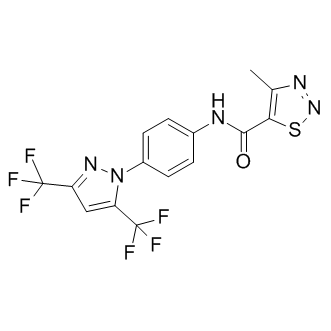| Cas No.: | 223499-30-7 |
| Synonyms: | YM58483; YM 58483; BPT2 |
| SMILES: | COC1=CC2=C(C=C1)OC(N3C2CC(C4=CC=CC=C4)=N3)C5=CC=CC([N+]([O-])=O)=C5 |
| Formula: | C15H9F5N5Os |
| M.Wt: | 421.32 |
| Purity: | >98% |
| Sotrage: | 4°C for 1 year, -20°C for more than 2 years |
| Description: | YM-58483 is the first selective and potent inhibitor of CRAC channels and subsequent Ca2+ signals. |
| In Vivo: | Intrathecal YM-58483 at the concentration of 300 μM (1.5 nmol) and 1000 μM (10 nmol) produces a significant central analgesic effect on the SNL rats[1]. In the mouse graft-versus-host disease (GVHD) model, YM-58483 (1-30 mg/kg, p.o.) and cyclosporine A (1-30 mg/kg, p.o.) inhibit donor anti-host cytotoxic T lymphocyte (CTL) activity and IFN-γ production, and also reduce the number of donor T cells, especially donor CD8+ T cells, in the spleen. YM-58483 (1-10 mg/kg, p.o.) and cyclosporine A (2, 10 mg/kg, p.o.) inhibit the sheep red blood cell (SRBC)-induced delayed type hypersensitivity (DTH) response[2]. M-58483 (30 mg/kg, p.o.) significantly suppresses ovalbumin (OVA)-induced bronchoconstriction in OVA-sensitized guinea pigs, whereas prednisolone does not. YM-58483 (3-30 mg/kg, p.o.) and prednisolone (100 mg/kg, p.o.) both significantly and completely suppress airway hyperresponsiveness (AHR) caused by OVA exposure[3]. YM-58483 inhibits antigen-induced eosinophil infiltration into airways, and decreases IL-4 and cysteinyl-leukotrienes content in inflammatory airways induced in actively sensitized Brown Norway rats. Orally administered YM-58483 prevents antigen-induced late phase asthmatic broncoconstriction and eosinophil infiltration in actively sensitized guinea pigs[4]. |
| In Vitro: | YM-58483 can decrease the levels of P-ERK and P-CREB, without affecting the expression of CD11b and GFAP. YM-58483 also inhibits the release of spinal cord IL-1β, TNF-α, and PGE2[1]. YM-58483 and cyclosporine A inhibits T cell proliferation in a one-way mixed lymphocyte reaction (mLR) with IC50 values of 330 and 12.7 nM, respectively[2]. YM-58483 inhibits DNP antigen-induced histamine release from and leukotrienes (LTs) production in IgE-primed RBL-2H3 cells, a rat basophilic leukemia cell line, with IC50 values of 460 and 310 nM, respectively. YM-58483 also inhibits phytohemagglutinin-P (PHA)-stimulated IL-5 and IL-13 production in human peripheral blood cells with IC50 values of 125 and 148 nM, respectively, which is approximately 5 times less potent than prednisolone[3]. YM-58483 inhibits IL-4 and IL-5 production in a conalbumine-stimulated murine Th2 T cell clone (D10.G4.1), and IL-5 production in phytohemagglutinin-stimulated human whole blood cells with IC50 values comparable to those reported for its CRAC channel inhibition (around 100 nM)[4]. |
| Animal Administration: | Male Balb/c mice are immunized by subcutaneous injection of SRBC (2×107 cells) on day 0. Immunized mice are challenged with 30 μL of 1×108 SRBC into the left hind footpad on day 5. Footpad swelling is measured 24 h after the challenge using a thickness gauge and expressed as the difference between the thickness of the left footpad and that of the right one, which receives an equal volume of 0.9% saline. As a negative control, male Balb/c mice are injected with 0.9% saline and challenged with SRBC. YM-58483 and cyclosporine A are administered orally once daily from day 0 to day 5 (6 consecutive days). |
| References: | [1]. Qi Z, et al. The Central Analgesic Mechanism of YM-58483 in Attenuating Neuropathic Pain in Rats. Cell Mol Neurobiol. 2016 Oct;36(7):1035-43. [2]. Ohga K, et al. Characterization of YM-58483/BTP2, a novel store-operated Ca2+ entry blocker, on T cell-mediated immune responses in vivo. Int Immunopharmacol. 2008 Dec 20;8(13-14):1787-92 [3]. Ohga K, et al. The suppressive effects of YM-58483/BTP-2, a store-operated Ca2+ entry blocker, on inflammatory mediator release in vitro and airway responses in vivo. Pulm Pharmacol Ther. 2008;21(2):360-9. [4]. Yoshino T, et al. YM-58483, a selective CRAC channel inhibitor, prevents antigen-induced airway eosinophilia and late phase asthmatic responses via Th2 cytokine inhibition in animal models. Eur J Pharmacol. 2007 Apr 10;560(2-3):225-33. |

 DC Chemicals' products qualify for U.S. tariff exemptions. We guarantee no price increases due to customs duties and maintain stable supply, continuing to deliver reliable research solutions to our American clients.
DC Chemicals' products qualify for U.S. tariff exemptions. We guarantee no price increases due to customs duties and maintain stable supply, continuing to deliver reliable research solutions to our American clients.





















